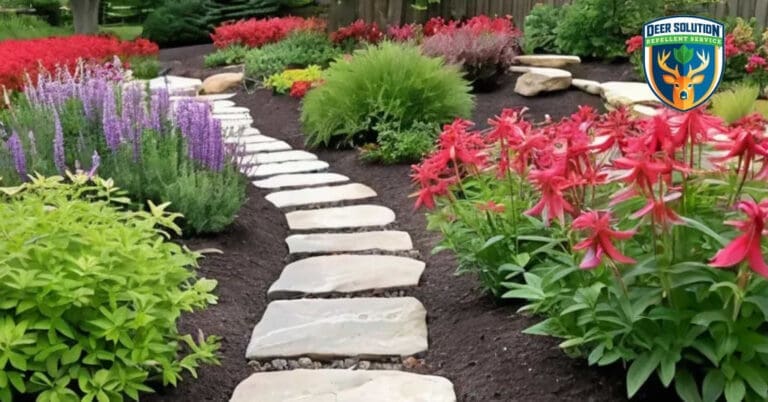Eastern Red Columbines (Aquilegia canadensis) are cherished for their vibrant red and yellow blooms that add a burst of color to any garden. However, gardeners often face the challenge of protecting these beautiful native plants from deer. Understanding the ecological role of Eastern Red Columbines, their relationship with local wildlife, and how to help them thrive despite deer pressure can empower gardeners to cultivate a resilient and biodiverse landscape.
The Ecological Role of Eastern Red Columbines
Supporting Pollinators and Wildlife
Eastern Red Columbines play a crucial role in supporting pollinators, particularly hummingbirds and native bees. The plant’s distinctive flowers, with their tubular shape and vibrant red color, are perfectly adapted to attract hummingbirds, which feed on the nectar and, in turn, pollinate the plants. Native bees are also drawn to the flowers, making Eastern Red Columbines a vital part of the local ecosystem.
Deer browsing can disrupt this delicate balance by damaging the flowers before they can be pollinated. When Eastern Red Columbines are grazed by deer, it can reduce the plant’s ability to reproduce, potentially impacting the populations of pollinators that rely on them. This makes protecting these plants from deer not just a matter of garden aesthetics, but also an important ecological consideration.
Contribution to Garden Biodiversity
Beyond their role as pollinator magnets, Eastern Red Columbines contribute to the overall biodiversity of a garden. These plants are native to North America and are well-adapted to local conditions, making them a resilient choice for gardeners aiming to create sustainable landscapes. By fostering a diverse array of plants, including Eastern Red Columbines, gardeners can create ecosystems that are more resistant to pests, diseases, and environmental stressors.
Incorporating Eastern Red Columbines into your garden helps to create a habitat that supports a wide range of species, from insects to birds. This biodiversity, in turn, enhances the resilience of your garden, making it better able to withstand challenges like deer browsing. Protecting these plants is essential to maintaining this balance and ensuring that your garden continues to thrive.
Regional Differences in Deer Behavior
Climate Impact
The behavior of deer toward Eastern Red Columbines can vary significantly depending on the climate. In cooler, northern climates, deer may find fewer alternative food sources during early spring, making them more likely to nibble on plants like Eastern Red Columbines. Conversely, in warmer, southern regions, where food is more abundant year-round, deer might be less likely to target these plants.
Understanding how climate influences deer behavior can help gardeners anticipate potential challenges. For example, in regions with harsh winters followed by a scarcity of food in early spring, extra precautions may be needed to protect Eastern Red Columbines from hungry deer. This could involve using protective measures such as deer netting during vulnerable periods or planting the columbines in less accessible areas of the garden.
Deer Population Density
Local deer population density also plays a crucial role in determining whether Eastern Red Columbines will be targeted. In areas with high deer populations, competition for food can be intense, leading deer to graze on plants they might otherwise avoid. This means that even in regions where Eastern Red Columbines are generally not a preferred food source, they may still be at risk if deer numbers are high.
In rural areas or suburban fringes where deer populations are often dense, gardeners might need to implement more robust protection strategies for their Eastern Red Columbines. This could include using professional repellent services that provide regular treatments to deter deer, ensuring continuous protection throughout the growing season.
Ecological Relationships: Eastern Red Columbines and Pollinators
Pollinator Attraction
The unique structure of Eastern Red Columbine flowers is perfectly suited to attract specific pollinators, particularly hummingbirds. The flowers’ tubular shape and bright red color are key features that appeal to these birds, which feed on the nectar and, in the process, pollinate the plants. This relationship is mutually beneficial—hummingbirds receive nourishment, while the columbines are able to reproduce and spread.
Native bees are also attracted to Eastern Red Columbines, although they may use different parts of the flower or visit at different times than hummingbirds. This diversity in pollinator attraction further underscores the ecological importance of these plants in supporting a healthy garden ecosystem.
Impact of Deer Grazing
Deer grazing can have a significant impact on the pollination process. When deer consume the flowers or young shoots of Eastern Red Columbines, they not only reduce the plant’s visual appeal but also its ability to attract pollinators. This disruption can have a cascading effect on the garden’s biodiversity, as pollinators may move elsewhere if their preferred plants are damaged or absent.
Protecting Eastern Red Columbines from deer is, therefore, crucial to maintaining their role in the ecosystem. By ensuring that these plants are not overgrazed, gardeners can support healthy pollinator populations, which in turn help to sustain the overall health of the garden.
Creating a Pollinator-Friendly Garden
To maximize the ecological benefits of Eastern Red Columbines, gardeners should focus on creating a pollinator-friendly environment that also protects these plants from deer. This can involve strategic planting, such as placing columbines near plants that are known to deter deer or using physical barriers during the early growing season.
Incorporating a variety of nectar-rich plants that bloom at different times can help attract and support a diverse range of pollinators. By designing your garden with both pollinators and deer protection in mind, you can create a space that is both beautiful and ecologically balanced.
Adaptation Strategies: How Eastern Red Columbines Survive in Deer-Heavy Areas
Growth Patterns
Eastern Red Columbines have developed several growth patterns that help them survive in environments where deer are present. One key strategy is their ability to self-seed prolifically. Even if a few plants are damaged by deer, the seeds they produce can sprout into new plants, helping the population to recover and even expand.
These plants are also known for their preference for rocky, well-drained soils, often growing in crevices or on slopes where deer may find it difficult to reach. This natural positioning can provide a degree of protection, as deer are less likely to browse in these harder-to-reach areas.
Seasonal Timing
The timing of Eastern Red Columbine growth and blooming also plays a role in their survival. These plants often bloom in early spring, which coincides with the time when many deer are still recovering from winter and may be more selective about their food sources. By the time deer begin to browse more actively, the columbines may already have set seed, ensuring the next generation’s survival.
Understanding these natural growth and blooming patterns can help gardeners plan their protection strategies more effectively. For example, providing temporary protection during early spring, when the plants are most vulnerable, can be an effective way to ensure their long-term survival.
Gardener Interventions
Gardeners can support the natural resilience of Eastern Red Columbines by implementing a few strategic interventions. Planting these columbines in mixed borders with more deer-resistant species can help shield them from grazing. Additionally, using temporary barriers like netting or protective cages during the early growing season can prevent deer from accessing the plants when they are most vulnerable.
Another effective strategy is to allow Eastern Red Columbines to self-seed freely in the garden. By encouraging this natural reproduction process, gardeners can ensure a steady supply of new plants, even if some are lost to deer browsing. This approach not only helps maintain the population of columbines but also enhances the overall biodiversity of the garden.
Integrating Eastern Red Columbines into Your Sustainable Garden
Eastern Red Columbines offer a unique blend of beauty, ecological value, and resilience, making them an excellent choice for sustainable gardens. By understanding their role in supporting pollinators, adapting to regional deer behavior, and utilizing their natural growth strategies, gardeners can successfully incorporate these native plants into their landscapes.
To maximize the success of Eastern Red Columbines in your garden, consider working with professionals who specialize in deer management, like Deer Solution. Their expertise can help you protect these valuable plants while maintaining the ecological balance of your garden. By integrating Eastern Red Columbines into a well-planned, sustainable garden, you not only enhance the beauty of your space but also contribute to the health of the local ecosystem.












